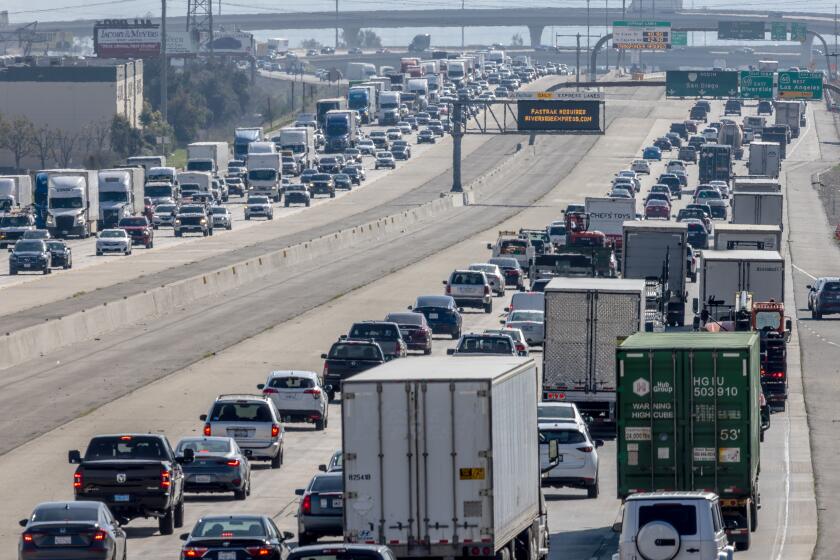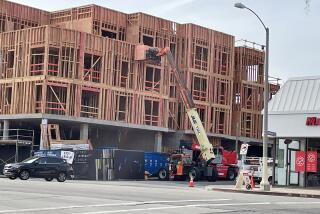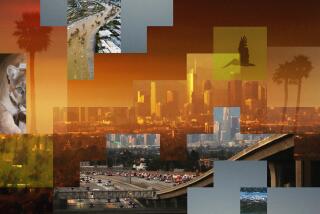Opinion: Metro needs to stop making traffic — and climate disasters — worse

- Share via
As fires were still burning above the hills of Pacific Palisades, Altadena and Malibu, L.A. County Metro took steps to widen more highways. This time it is a potential $5-billion-plus megaproject to expand the 605, 5, 10, 60 and 105 freeways.
At some point, our rhetoric on climate change must catch up with the incessant desire by elected officials to widen roads across Los Angeles. Widening highways induces more people to drive on them. This in turn increases emissions (and traffic, despite the stated argument for many of these projects being to minimize congestion), worsening climate change — and deadly fires. In fact, a study out last week found that climate change made the Los Angeles County fires more likely to take place by 35%, and increased their intensity by 6%.
Little has changed since I wrote in 2022 that L.A. is spending tens of billions of dollars to make climate change and traffic worse. As a region, we need to ask ourselves a simple question: Do we believe that the climate is warming due to man-made causes? If you don’t believe the climate is changing, or that human actions are central to those changes, then you’re ignoring the science.
California’s approach to freeway expansions is a paradox. Can we handle the potential solution?
According to the National Oceanic and Atmospheric Administration, by “increasing the abundance of greenhouse gases in the atmosphere, human activities are amplifying Earth’s natural greenhouse effect.” The single biggest source of greenhouse gases emitted in California is transportation, with people driving in cars making up the largest portion.
Policy changes have shown time and again that the more we encourage people to drive, the more they will drive, and the worse climate change will get. By widening highways, L.A. County Metro (and the California Department of Transportation) are inducing more people to drive on them. Remember when we widened the 405 through West Los Angeles at a cost of over $1.6 billion? In the year that followed the completion of the project, commute times (and emissions) got worse compared to before the project. The same is poised to happen with Metro’s extensive list of future highway-widening projects.
Some politicians may note that voters backed highway widening when they passed Measures R and M, two countywide sales tax increases that fund Metro’s rail, bus and highway expansion. However, voters didn’t vote for highway expansion specifically — they voted for congestion relief on specific corridors. Widening highways is the opposite of relieving congestion.
A better solution would be to invest in bus rapid transit and rail, connected by quality bike and pedestrian infrastructure. We could also repurpose general travel lanes on highways into express lanes or carpool lanes, without adding another lane to the highway. Yet we continue to widen highways as if it’s the only solution to traffic, when the data suggest it’s the opposite.
Politicians have an agenda when they bring up forestry management or a Jewish space laser. They’re trying to change the subject from fossil-fuel-driven climate change.
Others might say that the state’s shift to electric vehicles will offset the emissions increases. But switching to electric cars isn’t enough. EVs still pollute in their production, transportation and charging; the average EV pollutes about 50% less than a comparable gas-powered car. We also don’t have nearly enough power infrastructure to support wide-scale charging, and much of the power we do have still comes from fossil fuel sources. But most importantly, EVs take up just as much space as non-EVs, acting as an impetus to widen more roads and build more parking spaces. Because they tend to be heavier than gas-powered cars, they can be even more dangerous in the event of a crash for anyone outside of a car, and also wear down roads faster, requiring use of more asphalt, a semi-solid form of petroleum. We need fewer cars overall in Los Angeles, not just cars that run on something other than gasoline.
As we reel from the horrific fires that our region has experienced in recent weeks, we need to build back better, not the same. In addition to solutions such as fire-resistant materials in the new houses that are approved to replace the ones that burned down, we should also consider whether it’s smart to continue to invest in a transportation system nearly exclusively devoted to private vehicles. In addition to fueling our climate crisis, expecting everyone to drive their own large metal box through congested streets to evacuate during natural disasters can actually be dangerous; giving people high-quality alternatives to get around Los Angeles is key.
We should stop blindly following a made-up doctrine that we must widen highways because of the will of the voters. The voters want solutions, not an exacerbation of the problem. It’s time for Metro to take one of our most pressing problems seriously and stop doing things we know will make climate change — and future natural disasters — worse.
Michael Schneider is the founder of Streets for All.
More to Read
A cure for the common opinion
Get thought-provoking perspectives with our weekly newsletter.
You may occasionally receive promotional content from the Los Angeles Times.












